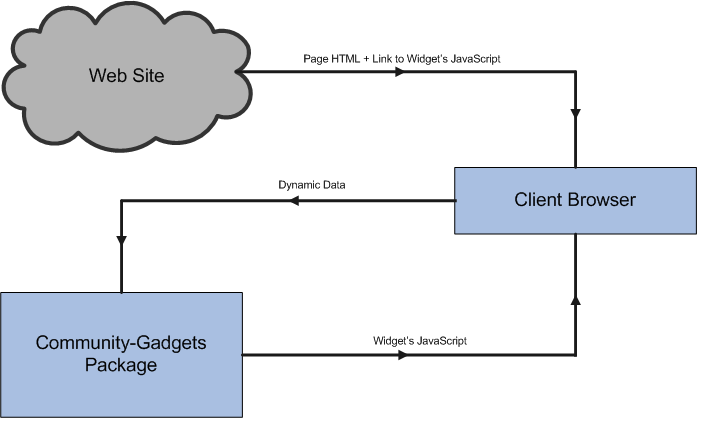79 About Oracle WebCenter Sites: Community-Gadgets
Oracle WebCenter Sites: Community-Gadgets is a social computing web application designed to gather visitors' comments, reviews, and ratings on web site content. Community-Gadgets also enables administrators and moderators to create and manage polls that can be used to survey site visitors about desired topics.
This chapter contains the following sections:
-
Section 79.1, "Introduction to Oracle WebCenter Sites: Community-Gadgets"
-
Section 79.2, "Community-Gadgets Management and Production Components"
-
Section 79.3, "Technical Overview of Oracle WebCenter Sites: Community-Gadgets"
79.1 Introduction to Oracle WebCenter Sites: Community-Gadgets
Community-Gadgets is a set of JavaEE web applications that integrates with Oracle WebCenter Sites and works in a distributed environment as a social computing application. Community-Gadgets provides it users with two Web Experience Management (WEM) applications:
-
Community WEM application: Provides the Community interface, which is used to configure widgets for collecting visitors' comments, reviews, ratings, and votes at polls. The Community WEM application is also used to moderate user-generated content.
-
Gadgets WEM application: Provides the Gadgets administrator interface (Global Catalog) and the Gadgets user interface. Which interface is displayed to the user depends on the user's roles. Both interfaces are used for gadgets management, which includes registering, sharing, and configuring gadgets and the dashboard.
For more information about the WEM Framework and WEM applications, see the Oracle Fusion Middleware WebCenter Sites Administrator's Guide and the Oracle Fusion Middleware WebCenter Sites Developer's Guide.
79.2 Community-Gadgets Management and Production Components
Community-Gadgets consists of two parts: a management set of applications, and a production (delivery) set of applications.
Note:
Management Community-Gadgets and production Community-Gadgets must be deployed on separate application server instances. Deployment of both on a single application server is not supported.
-
Management Community-Gadgets contains two web applications:
-
Community-Gadgets web application
-
Shindig web application
-
-
Production Community-Gadgets contains three web applications:
-
Community-Gadgets web application
-
Shindig web application
-
CAS web application
-
Management Community-Gadgets is used for the administration of user-generated content (UGC), registering gadgets, and similar functions. For security reasons, it is typically accessible only internally. Production Community-Gadgets is accessed by visitors through widgets and gadget dashboards deployed onto web pages. It manages visitor authorization through Visitors CAS.
Both management and production Community-Gadgets use Shindig OpenSocial container for rendering gadgets. Production Community-Gadgets must be externally accessible. More information about the Shindig web application is available at the following URL:
http://shindig.apache.org/
79.3 Technical Overview of Oracle WebCenter Sites: Community-Gadgets
Community-Gadgets functionality such as comments, reviews, and polls is developed as separate modules called widgets. Each widget can be deployed on a web site by using its JavaScript code snippet, which renders the widget in a browser. The ability to deploy widgets in a browser makes deployment simple and platform-independent. The widget deployment approach also facilitates high scale maintenance and upgrades.
Community-Gadgets widgets are compatible with most server-side and backend technologies, and therefore, there are no major deployment prerequisites that developers must know of. Since Community-Gadgets is an add-on for WebCenter Sites, it can be developed separately from WebCenter Sites.
The use of JavaScript enables developers to create easy-to-use and feature-rich widget interfaces. Developers can build dynamic screens that are responsive to user actions and do not require the whole web page to be re-loaded. As soon as a widget is deployed on a web page, it starts rendering and loading dynamic content such as lists of comments, reviews, or particular poll information from the data repository. The data for a widget is loaded using JavaScript, with the help of a remote scripting technology similar to AJAX. This technology also facilitates the deployment of the Community-Gadgets web application on a domain other than the original web site domain. Figure 79-1 shows the post-deployment web site environment.
Figure 79-1 Client Web Site Environment After Deploying Community-Gadgets Functionality

Description of "Figure 79-1 Client Web Site Environment After Deploying Community-Gadgets Functionality"
To become familiar with the Community-Gadgets object data model on which the Community-Gadgets widgets are based, see Section 81.1, "Overview of Community-Gadgets Data Model."
79.4 Prerequisites
Developers must understand how the Community-Gadgets web application is installed and know the Community interface and the Gadgets interface. To effectively use this guide, developers must have experience with the following:
-
WEM Framework, REST API, and WEM Admin interface.
-
Oracle WebCenter Sites asset model and Oracle WebCenter Sites: Satellite Server for caching.
-
Central Authentication Service (CAS) used for Web Single Sign-On.
-
Deployment of web applications on Oracle WebLogic Server, WebSphere Application Server or Tomcat application server.